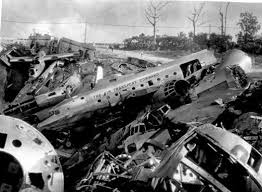Salvaging Planes

Salvaging Planes
The metrics are simple: When the cost of overhauling engines exceeds the value of the airplane,it is time to get into salvaging planes. Every year scores of near, or over-retirement-age aircraft are snapped up by experienced operators and users new to business class aviation, get into salvaging planes, because they can be acquired for relatively little. And when those airplanes wear out, those same operators look to ship the airplane off to parts dealers and salvage companies.
“There is some gold in each of these old airplanes,” the low-cost operator acquaintance explained. “The gold is in the systems, airframe hardware – even the run-out engines. So we get a nice price from a salvager, who either ferries the airplane to its last airport or sends a truck to pull the wings and ship everything back to his salvage operation.”
This pilot thinks of the routine as an “airframe organ-donation program”, providing transplant components to other, still-viable airframes. As new airplane sales go these days, so goes the aircraft recycling business. It’s not booming as it was a few years ago, but it’s still solid and a viable option for anyone with an older aircraft edging nearer its retirement.
The salvage approach offers some notable appeal as opposed to simply parking the airplane and walking away.
The key to maximizing the return for aircraft salvage is finding a salvager who understands the process, and applies best practices for protecting the environment and ‘extracting the gold from the old’. These companies can also assess a value of the components and pay a reasonable price for an aircraft no longer worth the investment to keep aloft.
Multiple Systems Flying in Close Formation
To highlight the complexity and potential for parting out an end-of-life airplane, consider these areas in which an entire system operates, from the ground up:
• Landing Gear System: Main gear legs; trunnions; wheels; brakes; down-locks; up-locks; gear doors; and the associated hardware needed to reposition the gear between down-and-locked and up-and-clean.
• Cabin Pressurization System: Plumbing to take bleed air off turbine-engine compressor sections; plumbing to route that air through an intercooler to the cabin; and an outflow valve to modulate the pressurization level in the aircraft.
• Cabin Amenities: Seats; tables; lights; fresh-air vents; galley and lavatory parts. In-flight entertainment equipment, and any cabin electronics (phones, Internet routers, and the like).
• Cockpit Systems: Flight crew seats (and in some cases jump seats); avionics systems; powerplant controls; flight and air-data instruments, radios and intercoms.
• Powerplants, Control Linkages & Associated Hardware: Even engines due an overhaul can have viable components – all of them expensive to buy, but less expensive to check against life limits for possible use in other engines.
• Trim & Fabrics: Aside from the furniture, the cabin also yields plastic or composite side panels, foam from seats…even the cabin windows can be salvaged.
• The Airframe: There’s lots of valuable metals in a modern business-turbine aircraft, most of it expensive aluminum, but also various kinds of steel, titanium and other exotic metals.
A salvager finds plenty of ‘gold’ after stripping the aircraft down to its shell. Depending on the aircraft the yield of aluminum alone can run into tens of thousands of pounds; copper wire, stainless steel tubing, and other metals all add up to help the salvage person recoup the cost. Engine nacelles, flaps, ailerons, leading-edge cuffs, landing gear and more have value.
Meanwhile, the practice of stripping out aircraft for recyclable materials and viable components involves handling materials considered toxic to the environment, which tends to be highly regulated. Failing to comply can pose significant penalties. Hydraulic fluids, fuels, oils and lubricants require special handling and disposal practices. And if an aircraft sports an installed lavatory, that means handling biological waste materials.
Some owners may not realize the complexity and responsibilities of handling these should they opt to try stripping out the airplane themselves. Others, not recognizing the potential value of the salvageable materials, may simply abandon the airplane far from view.
Ensuring a Sound Salvage
Scrapping a modern aircraft can involve regulatory issues similar to maintaining the aircraft in an airworthy condition. The FAA still has oversight of parts deemed worth returning to service, but it’s the EPA and state environmental rules instead of the FAA that make the salvage business one that’s best left to the pros.
In some parts of the world finding the salvage operation may be as easy as looking up a used-parts purveyor; the chances are that much of their inventory came from run-out aircraft they purchased and processed for their re-usable parts and components. Elsewhere it may be necessary to look further afield. One good place to start is the Aircraft Fleet Recycling Association (AFRA), which sets accreditation standards, provides guides to responsible salvaging and a connection between its members and people in need of their services.
Don’t Abandon Your Plane!
As several companies noted, abandoning an aircraft that’s worn out may still leave the owner liable for storage charges and any environmental issues stemming from fluids leaking onto the tarmac. In some cases, airports have sought out former owners of abandoned aircraft and served them with papers demanding payment for parking, storage, environmental damage and, occasionally, property taxes now due because the aircraft can no longer be claimed as a business tool.

